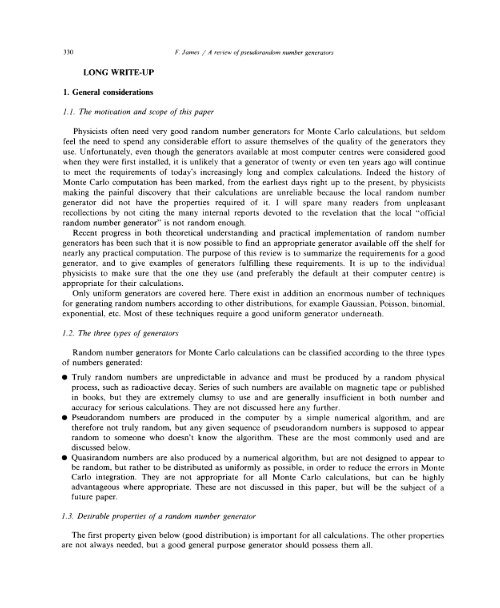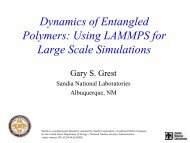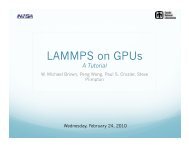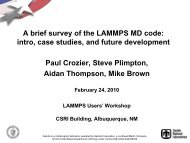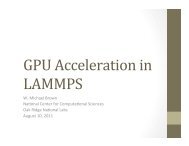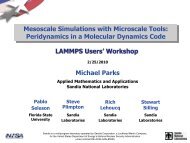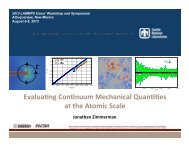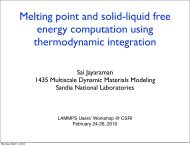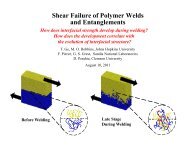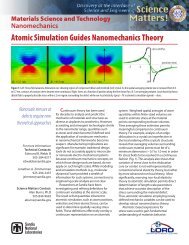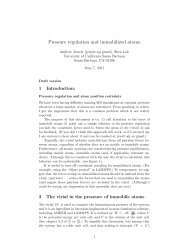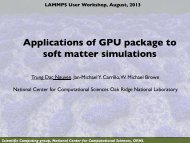A review of pseudorandom number generators - Lammps
A review of pseudorandom number generators - Lammps
A review of pseudorandom number generators - Lammps
You also want an ePaper? Increase the reach of your titles
YUMPU automatically turns print PDFs into web optimized ePapers that Google loves.
330 F. James / A <strong>review</strong> <strong>of</strong><strong>pseudorandom</strong> <strong>number</strong> <strong>generators</strong><br />
LONG WRITE-UP<br />
1. General considerations<br />
1.1. The motivation and scope <strong>of</strong> this paper<br />
Physicists <strong>of</strong>ten need very good random <strong>number</strong> <strong>generators</strong> for Monte Carlo calculations, but seldom<br />
feel the need to spend any considerable effort to assure themselves <strong>of</strong> the quality <strong>of</strong> the <strong>generators</strong> they<br />
use. Unfortunately, even though the <strong>generators</strong> available at most computer centres were considered good<br />
when they were first installed, it is unlikely that a generator <strong>of</strong> twenty or even ten years ago will continue<br />
to meet the requirements <strong>of</strong> today’s increasingly long and complex calculations. Indeed the history <strong>of</strong><br />
Monte Carlo computation has been marked, from the earliest days right up to the present, by physicists<br />
making the painful discovery that their calculations are unreliable because the local random <strong>number</strong><br />
generator did not have the properties required <strong>of</strong> it. I will spare many readers from unpleasant<br />
recollections by not citing the many internal reports devoted to the revelation that the local “<strong>of</strong>ficial<br />
random <strong>number</strong> generator” is not random enough.<br />
Recent progress in both theoretical understanding and practical implementation <strong>of</strong> random <strong>number</strong><br />
<strong>generators</strong> has been such that it is now possible to find an appropriate generator available <strong>of</strong>f the shelf for<br />
nearly any practical computation. The purpose <strong>of</strong> this <strong>review</strong> is to summarize the requirements for a good<br />
generator, and to give examples <strong>of</strong> <strong>generators</strong> fulfilling these requirements. It is up to the individual<br />
physicists to make sure that the one they use (and preferably the default at their computer centre) is<br />
appropriate for their calculations.<br />
Only uniform <strong>generators</strong> are covered here. There exist in addition an enormous <strong>number</strong> <strong>of</strong> techniques<br />
for generating random <strong>number</strong>s according to other distributions, for example Gaussian, Poisson, binomial,<br />
exponential, etc. Most <strong>of</strong> these techniques require a good uniform generator underneath.<br />
1.2. The three types <strong>of</strong> <strong>generators</strong><br />
Random <strong>number</strong> <strong>generators</strong> for Monte Carlo calculations can be classified according to the three types<br />
<strong>of</strong> <strong>number</strong>s generated:<br />
• Truly random <strong>number</strong>s are unpredictable in advance and must be produced by a random physical<br />
process, such as radioactive decay. Series <strong>of</strong> such <strong>number</strong>s are available on magnetic tape or published<br />
in books, but they are extremely clumsy to use and are generally insufficient in both <strong>number</strong> and<br />
accuracy for serious calculations. They are not discussed here any further.<br />
• Pseudorandom <strong>number</strong>s are produced in the computer by a simple numerical algorithm, and are<br />
therefore not truly random, but any given sequence <strong>of</strong> <strong>pseudorandom</strong> <strong>number</strong>s is supposed to appear<br />
random to someone who doesn’t know the algorithm. These are the most commonly used and are<br />
discussed below.<br />
• Quasirandom <strong>number</strong>s are also produced by a numerical algorithm, but are not designed to appear to<br />
be random, but rather to be distributed as uniformly as possible, in order to reduce the errors in Monte<br />
Carlo integration. They are not appropriate for all Monte Carlo calculations, but can be highly<br />
advantageous where appropriate. These are not discussed in this paper, but will be the subject <strong>of</strong> a<br />
future paper.<br />
1.3. Desirable properties <strong>of</strong> a random <strong>number</strong> generator<br />
The first property given below (good distribution) is important for all calculations. The other properties<br />
are not always needed, but a good general purpose generator should possess them all.


